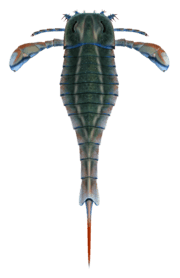Cyrtoctenus
| Cyrtoctenus | |
|---|---|
| Scientific classification | |
| Kingdom: | Animalia |
| Phylum: | Arthropoda |
| Subphylum: | Chelicerata |
| Order: | †Eurypterida |
| Superfamily: | †Mycteropoidea |
| Family: | †Hibbertopteridae |
| Genus: | †Cyrtoctenus Størmer & Waterston, 1968 |
| Type species | |
| †Cyrtoctenus peachi Størmer & Waterston, 1968 | |
| Species | |
| |
Cyrtoctenus is a genus of prehistoric eurypterid classified within the family Hibbertopteridae. The genus contains six species, ranging in temporal range from the Devonian to the Carboniferous.[1]
Cyrtoctenus wittebergensis is one of the few eurypterids known from the southern hemisphere, where eurypterid finds are rare and usually fragmentary.[2]
Description
Cyrtoctenus was a gigantic Hibbertopterid eurypterid, with C. wittebergensis reaching lengths of around 1.5 meters. The anterior movable spines of the distal podomeres on the second, third and fourth prosomal appendages were modified to form "fingers" associated with fixed combs developed as modifications of the posterior spine.[2]
Cyrtoctenus had further adaptations towards sweep-feeding than other hibbertopterids, with its blades modified into comb-like rachis that could entrap smaller prey or other organic food particles. With its coxae being large, it is likely that Cyrtoctenus would also feed on relatively large invertebrates when able to.[3]
Classification
It is believed that some of the genera within the Hibbertopteridae represent synonyms of each other. Four of the genera in the family, Campylocephalus, Hastimima, Dunsopterus and Vernonopterus are clearly hibbertopterids but known from very incomplete specimens. Further discoveries may point to that some of them are synonymous with either Hibbertopterus or Cyrtoctenus.[3]
Furthermore, Cyrtoctenus and Hibbertopterus might represent different ontogenetic stages of each other, where rachis would have developed in the later moult stages. This would also explain why smaller Hibbertopterus specimens are more complete than the fragmentary remains known of Cyrtoctenus, as the majority of Hibbertopterus specimens would represent exuviae whilst Cyrtoctenus specimens represent actual mortalities susceptible to scavengers.[3]
Species
The species currently seen as valid species of the genus are:[1]
- Cyrtoctenus caledonicus Salter, 1863 — Carboniferous, Scotland.
- Cyrtoctenus dewalquei Fraipont, 1889 — Devonian, Belgium.
- Cyrtoctenus dicki Peach, 1883 — Carboniferous, Scotland.
- Cyrtoctenus ostraviensis Augusta & Přibyl, 1951 — Carboniferous, Czech Republic.
- Cyrtoctenus peachi Størmer & Waterston, 1968 — Carboniferous, Scotland.
- Cyrtoctenus wittebergensis Waterston, Oelofsen & Oosthuizen, 1985 — Carboniferous, South Africa.
See also
References
- 1 2 Dunlop, J. A., Penney, D. & Jekel, D. 2015. A summary list of fossil spiders and their relatives. In World Spider Catalog. Natural History Museum Bern, online at http://wsc.nmbe.ch, version 16.0 http://www.wsc.nmbe.ch/resources/fossils/Fossils16.0.pdf (PDF).
- 1 2 D. Waterston, C; W. Oelofsen, B; D. F. Oosthuizen, R (1985-01-01). "Cyrtoctenus wittebergensis sp. nov. (Chelicerata: Eurypterida), a large sweep-feeder from the Carboniferous of South Africa". Transactions of the Royal Society of Edinburgh: Earth Sciences. 76: 339–358. doi:10.1017/S0263593300010555.
- 1 2 3 James C. Lamsdell, Simon J. Braddy & O. Erik Tetlie (2010). "The systematics and phylogeny of the Stylonurina (Arthropoda: Chelicerata: Eurypterida)". Journal of Systematic Palaeontology. 8 (1): 49–61. doi:10.1080/14772011003603564.
